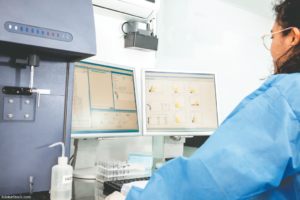 For patients with rheumatoid arthritis (RA), analyzing immune cell diversity in peripheral blood revealed five major immunotype groups, each exhibiting a different response to various biologic or targeted synthetic disease-modifying anti-rheumatic drugs (DMARDs). This is according to a 2024 study published in Annals of the Rheumatic Disease that aimed to stratify the patients based on their immunophenotypes, providing a basis for precision medicine.
For patients with rheumatoid arthritis (RA), analyzing immune cell diversity in peripheral blood revealed five major immunotype groups, each exhibiting a different response to various biologic or targeted synthetic disease-modifying anti-rheumatic drugs (DMARDs). This is according to a 2024 study published in Annals of the Rheumatic Disease that aimed to stratify the patients based on their immunophenotypes, providing a basis for precision medicine.
“The primary focus in the treatment strategy for RA is the achievement of precision medicine,” explains first author Satoshi Kubo, MD, PhD, an associate professor in the Department of Molecular Targeted Therapies of the University of Occupational and Environmental Health, Kitakyushu, Japan. “In this study, we analyzed immunophenotyping data from the peripheral blood of over 700 RA patients who had never received molecular targeted therapies, and we discovered three significant insights.
“First, the immunophenotypes of these patients are not uniform, but can be categorized into five distinct clusters. Second, each cluster, defined by immune phenotype, responds differently to various molecular targeted therapies. Third, a subset known as CD4 TEMRA may play a critical role in the pathology of some patients. The significance of these findings is as follows.
“The treatment of RA, as recommended by EULAR, involves phases 1, 2 and 3, with five classes of molecular targeted drugs used in phase 2 and beyond. However, there are no biomarkers for selecting these treatments. If it were feasible to implement the optimal molecular targeted therapy from the beginning—essentially employing a precision-medicine approach—the treatment of RA could be fundamentally transformed. Despite considerable efforts by many researchers, this goal has yet to be realized.”
Dr. Kubo continues, “In our study, we demonstrated that peripheral blood immunophenotyping could aid in selecting targeted molecular therapies, a finding we validated using a cohort. Our research illustrates a potential pathway for the realization of precision medicine.”
Immunophenotyping Study
The study included 533 patients with RA who were biologic or targeted synthetic DMARD naive and 96 healthy controls without autoimmune rheumatic diseases. The patient cohort included 76.4% women with a mean age of 63.5 years; 70.7% tested positive for the presence of anti-cyclic citrullinated peptide antibodies; 71.1% received methotrexate; and the mean Clinical Disease Activity Index (CDAI) stood at 27.1.
The healthy control cohort also comprised mainly women, at 70.8%, but the patients were younger, with a mean age of 47.6 years.
Researchers used flow cytometry to complete peripheral blood immunotyping for each participant. Patients with RA exhibited a substantial increase in the proportion of CD4+ effector memory T cells re-expressing CD45RA (TEMRA), amounting to 6.9% vs. 3.7% in healthy controls. Patients received treatment with various biologic or targeted synthetic DMARDs, including Janus kinase (JAK) inhibitors, tumor necrosis factor (TNF) inhibitors, interleukin (IL) 6 blockers and cytotoxic T lymphocyte-associated antigen 4 immunoglobulin (CTLA4-Ig).
Blood-based immunophenotyping enabled the researchers to stratify the patients into five groups on the basis of immune cell characteristics. The five groups showed different clinical features and varied responses to treatment, based on clinical remission at 26 weeks or achievement of low disease activity. The immunotype group comprising 74 patients with increased activated CD4+ T cells, CD8+ T cells and plasmablasts—indicating abnormalities in T cell and B cell differentiation—showed the highest disease activity, as measured by CDAI. This group also exhibited the highest values for the Health Assessment Questionnaire, C-reactive protein and erythrocyte sedimentation rate. However, these values did not differ among the other immunotype groups.
JAK inhibitors were linked to increased efficacy across the groups. An increased efficacy of IL-6 inhibition occurred in a group of 93 patients—the youngest group with a mean age of 54 years—presenting with an immunotype almost identical to healthy controls. Another group of 134 patients exhibited reduced activated Tc1 cells, but otherwise displayed a similar immunophenotype to healthy controls.
TNF inhibition appeared more effective in the immunotype group of 139 patients with increased CD4 TEMRA.
Meanwhile, CTLA4-Ig appeared most effective in the group of 89 patients exhibiting an increase in Th1 cells in addition to CD4 TEMRA.
“Immune clusters in these patients cannot be distinctly delineated using existing clinical syndromes or serum markers. Contrarily, our findings reveal that certain groups of patients with RA exhibit immunophenotypic patterns similar to those found in healthy individuals,” the authors write.
The researchers noted that validating the difference in biologic or targeted synthetic DMARD efficacy within the five immunophenotype groups would require many more patients. Instead, they matched the patients with biologic or targeted synthetic DMARD expected or unexpected to be effective based on the immune profiles. The expected group outperformed the unexpected group, with a higher remission rate at 26 weeks, at 39.9% vs. 24.6%, and a greater achievement of low disease activity, at 80.8% vs. 60.2%.
The researchers validated the findings in a separate cohort of 183 patients with RA naive to biologic or targeted synthetic DMARDs, comprising 73.8% women with a mean age of 62.2 years. The expected group showed a higher remission rate than the unexpected group, at 33.5% vs. 18.2%.
“Our findings underscore the often-overlooked diversity among RA patients in routine clinical practice. We have demonstrated that stratifying patients has proven to be meaningful in both basic research and clinical practice,” Dr. Kubo says.
Research & Clinical Implications
“In academia, our results emphasize the significance of translational research, specifically clinical immunology, in addressing discrepancies between human and mouse studies,” Dr. Kubo says. “For clinical medicine, we have highlighted our expectations for the advancement of future precision medicine. Our findings also indicate that various critical cell subsets, such as CD4 TEMRA, contribute to the pathogenesis. By exploring the differentiation and regulation of these cell subsets, we possess the potential to identify novel target molecules for RA.
“In patients with RA, who exhibit considerable diversity, the critical question is determining the appropriate medication for each case,” concludes Dr. Kubo. “This study concentrated on assessing the heterogeneity of RA and successfully identified immune cell fractions that are unmeasurable in routine clinical settings, thus evaluating this diversity. Moreover, we demonstrated that this variability is instrumental in selecting targeted molecular therapies, marking an advancement towards the realization of precision medicine in the future.”
Commenting on the findings, Christian Lood, PhD, an associate professor in the Division of Rheumatology at the University of Washington, Seattle, notes that the study highlights the need for the “incorporation of blood-based markers in making treatment decisions on an individual basis, recognizing that not all treatments will be efficient for all individuals. This assumption is supported by several similar findings, including a recent study by our group demonstrating the clinical utility of blood-based immunophenotyping in guiding treatment decisions.”
Incorporating Blood-Based Markers
In a 2024 study, Dr. Lood and colleagues assessed whether baricitinib, a JAK1/JAK2 inhibitor, reduced neutrophil activation and whether a neutrophil activation score predicted treatment response.2
They used an enzyme-linked immunosorbent assay to measure neutrophil activation markers, calprotectin and neutrophil extracellular traps in plasma. The markers of neutrophil activation stood elevated in the 271 patients with RA compared with the 39 healthy controls. Baricitinib reduced calprotectin levels at 12 and 24 weeks, especially in patients responding to treatment. Elevated baseline levels of calprotectin and neutrophil extracellular traps could predict treatment response to baricitinib, but C-reactive protein levels could not distinguish responders from non-responders.”
“A deepened understanding of the heterogeneity of the disease and clinical utility of blood-based markers may change the way we view and perform clinical trials, focusing on patients with distinct molecular and/or cellular profiles anticipated to be targeted by the treatment rather than being all inclusive,” Dr. Lood says.
Referring to the study by Kubo et al., Dr. Lood notes that for rheumatologists, “this is a reminder that patients are individuals, and not all the same, with various pathologic mechanisms driving the disease resulting in different responses to targeted treatment. Of note from the current study, JAK inhibitors had a broad effect across various immunophenotypes whereas more targeted therapies, including IL-6 inhibitors or CTLA4-Ig, had limited effect in some immunophenotypes.”
For researchers, the study by Kubo et al. “highlights the continued need for a more granular understanding of the various disease mechanisms driving arthritis in facilitating disease stratification as well as the development of more targeted approaches to treat the disease,” Dr. Lood says. “It is also important to recognize that, albeit able to stratify patients, the current findings are of correlative nature, and that additional studies are required to determine whether the defining features, such as distinct CD4+ subsets, are causative in driving disease.”
Katie Robinson is a medical writer based in New York.
References
- Kubo S, Miyazaki Y, Nishino T, et al. Peripheral blood immunophenotypic diversity in patients with rheumatoid arthritis and its impact on therapeutic responsiveness. Ann Rheum Dis. 2024 Oct 4:ard-2024-226228.
- Kuley R, Duvvuri B, Hasnain S, et al. Neutrophil activation markers and rheumatoid arthritis treatment response to the JAK1/2 inhibitor baricitinib. Arthritis Rheumatol. 2024 Oct 21. Online ahead of print.
Contributor Disclosures
Dr. Kubo has received speaking fees from Eli Lilly, GlaxoSmithKline, Bristol Myers, AbbVie, Eisai, Pfizer and AstraZeneca, along with research grants from Daiichi Sankyo, AbbVie, Boehringer Ingelheim and Astellas.
Dr. Lood has received research funding from Pfizer, Gilead Sciences, Eli Lilly, Boehringer Ingelheim, Amytryx and Redd Pharma, consulted for Redd Pharma, Exagen and Citryll, and has stock options for Redd Pharma.



